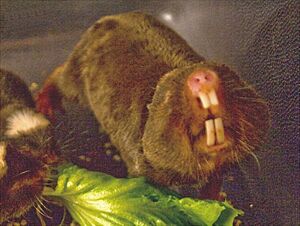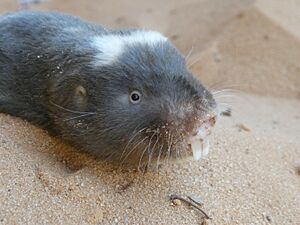Damaraland mole-rat facts for kids
Quick facts for kids Damaraland mole-rat |
|
|---|---|
 |
|
| Conservation status | |
| Scientific classification | |
| Genus: |
Fukomys
|
| Species: |
damarensis
|
| Synonyms | |
|
Cryptomys damarensis |
|
The Damaraland mole-rat (Fukomys damarensis) is a small animal that lives underground in southern Africa. It's a type of rodent, like a mouse or a rat. These mole-rats are special because they live in big, organized families called colonies. This way of living, where only a few animals reproduce and others help out, is called eusociality. The more famous naked mole rat also lives this way.
Contents
What Does a Damaraland Mole-Rat Look Like?
The Damaraland mole-rat has a body shaped like a cylinder, with short, strong legs and large feet. Its head is cone-shaped. It's about the same size as other African mole-rats.
From head to body, it measures about 14 to 20 centimeters (5.5 to 7.9 inches). Its tail is short, only about 2 to 3 centimeters (0.8 to 1.2 inches) long. These mole-rats usually weigh between 100 and 280 grams (3.5 to 9.9 ounces).
Special Features for Digging
Damaraland mole-rats don't have outside ears, and their tiny blue eyes are covered with thick eyelids. They have very large front teeth, called incisors, that stick out. Behind these teeth are flaps of skin. These flaps stop soil from getting into their throats when they use their teeth to dig tunnels.
Their fur is short and thick. It can be light brown, dark brown, or almost black. They always have a white patch on top of their head. This patch can be different shapes. Sometimes, they might have other white spots on their body too. They also have long whiskers on their face and other sensory hairs all over their body. Female mole-rats have six teats for feeding their babies.
Where Do Damaraland Mole-Rats Live?
Even though they are named after a place called Damaraland, these mole-rats live in many parts of southern Africa. You can find them in countries like Botswana, Namibia, South Africa, Zambia, and Zimbabwe.
They like warm, dry places with lots of scrubland or sandy grasslands. They are often found in sandy areas, especially where there are many plants with roots, tubers, or bulbs underground. These underground plant parts are their main food source.
Damaraland Mole-Rat Habits
Damaraland mole-rats are herbivores, meaning they only eat plants. They especially love eating tubers, corms, and bulbs that grow underground. Some of their favorite foods come from plants like Acanthosicyos, Star-of-Bethlehem, Ledebouria, and Talinum.
Their natural enemies include mole snakes and sometimes other snakes like cobras. These mole-rats get all the water they need from their food, so they don't need to drink. Their food also gives them important minerals.
Active Underground
Even though they live completely underground where it's always dark, Damaraland mole-rats have a daily rhythm, just like animals that live above ground. They are most active during the day. Scientists think they can tell the difference between light and dark, even if their eyesight isn't very good.
Life in the Tunnels
Damaraland mole-rats live in a network of tunnels that they dig with their strong front teeth. These tunnels are about 6.5 to 7.5 centimeters (2.6 to 3 inches) wide. A colony's tunnel system can stretch for up to 1 kilometer (0.6 miles)!
Their tunnels don't connect to the surface. You can tell they are there by the dome-shaped piles of dirt, called molehills, that they push up to the surface. Because the tunnels are sealed, they have their own special air inside. It's warm and moist, but it has low oxygen levels.
Mole-rats do most of their digging after it rains. Dry soil is too hard for them to dig through. In dry places, this means they can be super busy for short periods. One colony was found to dig up three tons of soil in just two weeks!
Inside the Tunnel System
The tunnel system has different parts. Most of the tunnels are for finding food. When they find a large tuber or bulb, they might eat part of it right there. Smaller ones are dragged back to special food storage rooms. These storage rooms are deeper underground.
The foraging tunnels are usually only 5 to 25 centimeters (2 to 10 inches) below the surface. But they connect to deeper tunnels that lead to the storage rooms, special bathrooms (latrines), and a central nest. The nest can be as deep as 2.5 meters (8.2 feet) underground!
Damaraland Mole-Rat Colonies
Each tunnel system is home to one colony of mole-rats. A typical colony has about twelve members, but some can have as few as two or as many as forty. These colonies are eusocial, which means they have a special structure. There's one breeding pair (a male and a female) that has all the babies. The other mole-rats in the colony are their offspring, and they don't reproduce.
The non-breeding mole-rats spend their time looking for food and keeping the tunnels in good shape. They are very good at fixing any breaks in the tunnels. Mole-rats from other colonies are usually not allowed to join.
Each colony has a clear pecking order. The breeding male is in charge, followed by the breeding female. Then come the non-breeding males, and finally the non-breeding females.
Leaving the Colony
If the breeding female dies, the colony usually breaks apart. Most of the surviving mole-rats will leave to find new homes. Very large mole-rats might also leave to start their own tunnel system.
When they leave, they usually do so during rainy weather. This makes it easier for them to dig new tunnels once they find a good spot. New colonies are started by unrelated males and females who become the new breeding pair.
Mole-rats that leave their colony travel above ground. This makes them easy targets for many predators. Studies show that only about 10 percent of mole-rats that leave a colony survive to start a new one. For example, if a small group of brothers and sisters leave together, usually only one will survive to create a new colony.
Damaraland mole-rats are not as noisy as naked mole-rats. They mostly make bird-like chirping sounds.
Reproduction and Life Cycle
Since they are eusocial animals, only the breeding pair in a colony can have babies. However, the non-breeding mole-rats are not truly unable to have babies. If they leave and start their own colony, they can become parents.
The female mole-rat starts the mating process by calling out and drumming her hind feet. Then, the male and female chase each other in a circle before they mate. They mate often over a ten-day period.
Pregnancy lasts about 78 to 92 days. A female can have up to three litters of babies each year. Each litter usually has one to six pups. When they are born, the pups are hairless and their eyes are closed. They weigh only about 8 to 9 grams (0.3 ounces). They stop drinking their mother's milk after 28 days and reach their adult size when they are about 14 months old.
Genetics
The Damaraland mole-rat has either 74 or 78 chromosomes in its cells.



